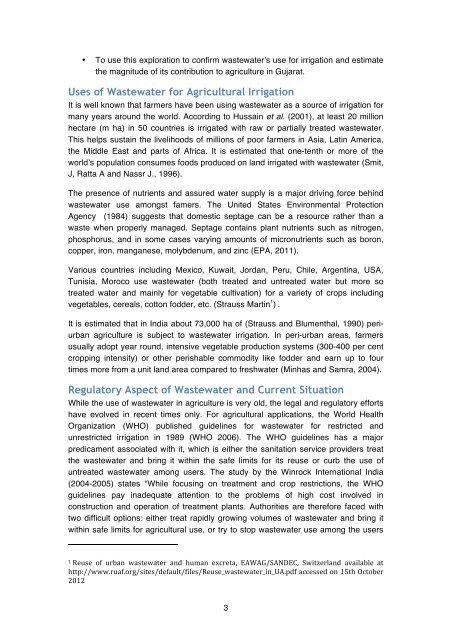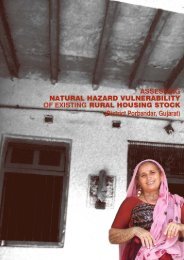Wastewater Irrigation in Gujarat - People in Centre Consulting
Wastewater Irrigation in Gujarat - People in Centre Consulting
Wastewater Irrigation in Gujarat - People in Centre Consulting
Create successful ePaper yourself
Turn your PDF publications into a flip-book with our unique Google optimized e-Paper software.
• To use this exploration to confirm wastewater’s use for irrigation and estimate<br />
the magnitude of its contribution to agriculture <strong>in</strong> <strong>Gujarat</strong>.<br />
Uses of <strong>Wastewater</strong> for Agricultural <strong>Irrigation</strong><br />
It is well known that farmers have been us<strong>in</strong>g wastewater as a source of irrigation for<br />
many years around the world. Accord<strong>in</strong>g to Hussa<strong>in</strong> et al. (2001), at least 20 million<br />
hectare (m ha) <strong>in</strong> 50 countries is irrigated with raw or partially treated wastewater.<br />
This helps susta<strong>in</strong> the livelihoods of millions of poor farmers <strong>in</strong> Asia, Lat<strong>in</strong> America,<br />
the Middle East and parts of Africa. It is estimated that one-tenth or more of the<br />
world’s population consumes foods produced on land irrigated with wastewater (Smit,<br />
J, Ratta A and Nassr J., 1996).<br />
The presence of nutrients and assured water supply is a major driv<strong>in</strong>g force beh<strong>in</strong>d<br />
wastewater use amongst famers. The United States Environmental Protection<br />
Agency (1984) suggests that domestic septage can be a resource rather than a<br />
waste when properly managed. Septage conta<strong>in</strong>s plant nutrients such as nitrogen,<br />
phosphorus, and <strong>in</strong> some cases vary<strong>in</strong>g amounts of micronutrients such as boron,<br />
copper, iron, manganese, molybdenum, and z<strong>in</strong>c (EPA, 2011).<br />
Various countries <strong>in</strong>clud<strong>in</strong>g Mexico, Kuwait, Jordan, Peru, Chile, Argent<strong>in</strong>a, USA,<br />
Tunisia, Moroco use wastewater (both treated and untreated water but more so<br />
treated water and ma<strong>in</strong>ly for vegetable cultivation) for a variety of crops <strong>in</strong>clud<strong>in</strong>g<br />
vegetables, cereals, cotton fodder, etc. (Strauss Mart<strong>in</strong> 1 ) .<br />
It is estimated that <strong>in</strong> India about 73,000 ha of (Strauss and Blumenthal, 1990) periurban<br />
agriculture is subject to wastewater irrigation. In peri-urban areas, farmers<br />
usually adopt year round, <strong>in</strong>tensive vegetable production systems (300-400 per cent<br />
cropp<strong>in</strong>g <strong>in</strong>tensity) or other perishable commodity like fodder and earn up to four<br />
times more from a unit land area compared to freshwater (M<strong>in</strong>has and Samra, 2004).<br />
Regulatory Aspect of <strong>Wastewater</strong> and Current Situation<br />
While the use of wastewater <strong>in</strong> agriculture is very old, the legal and regulatory efforts<br />
have evolved <strong>in</strong> recent times only. For agricultural applications, the World Health<br />
Organization (WHO) published guidel<strong>in</strong>es for wastewater for restricted and<br />
unrestricted irrigation <strong>in</strong> 1989 (WHO 2006). The WHO guidel<strong>in</strong>es has a major<br />
predicament associated with it, which is either the sanitation service providers treat<br />
the wastewater and br<strong>in</strong>g it with<strong>in</strong> the safe limits for its reuse or curb the use of<br />
untreated wastewater among users. The study by the W<strong>in</strong>rock International India<br />
(2004-2005) states “While focus<strong>in</strong>g on treatment and crop restrictions, the WHO<br />
guidel<strong>in</strong>es pay <strong>in</strong>adequate attention to the problems of high cost <strong>in</strong>volved <strong>in</strong><br />
construction and operation of treatment plants. Authorities are therefore faced with<br />
two difficult options: either treat rapidly grow<strong>in</strong>g volumes of wastewater and br<strong>in</strong>g it<br />
with<strong>in</strong> safe limits for agricultural use, or try to stop wastewater use among the users<br />
1"Reuse" of" urban" wastewater" and" human" excreta," EAWAG/SANDEC," Switzerland" available" at"<br />
http://www.ruaf.org/sites/default/files/Reuse_wastewater_<strong>in</strong>_UA.pdf"accessed"on"15th"October"<br />
2012"<br />
3




